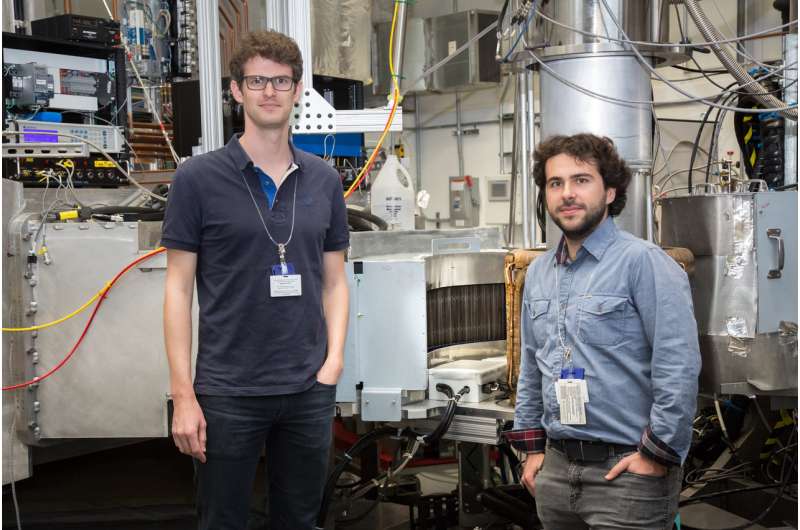Researchers seek existence of exotic quantum spin ice

Researchers from the Paul Scherrer Institute (PSI) in Switzerland, Romain Sibille and Nicolas Gauthier, are studying a fascinating sample using neutrons at the Department of Energy's (DOE's) Spallation Neutron Source (SNS) at Oak Ridge National Laboratory.
Their goal is to create an observable case of quantum spin ice, a bizarre magnetic state found in a special class of materials that could lead to advances in quantum computing technologies.
"We study mostly oxides, which include rare-earth magnetic elements," said Sibille. "Right now, we are studying a sample that's a candidate for a magnetic phase that, so far, has been hard to observe: quantum spin ice. We hope to find this and demonstrate it with the new capabilities here at SNS's HYSPEC instrument using polarization and the supermirror from PSI."
In 2015, HYSPEC, SNS beamline 14B, received a new wide-angle polarizing supermirror array built by scientists and engineers at PSI. The new supermirror enables users to perform three-dimensional polarization analysis of neutron excitations.
Studies of frustrated magnetism using neutron scattering continue to grow more popular among scientists, the researchers say, largely because of the possibility of finding these unique quantum states. Quantum spin ice in particular is part of a larger class of magnetic phases, or ground states, called "quantum spin liquids."
Spin ice is a magnetic substance that doesn't exhibit conventional magnetism, as seen in traditional bar magnets with north and south poles where the electrons align in parallel. Instead, the material's magnetic moments—or "spins"— arrange in disordered or "frustrated" states and fluctuate between different configurations, even in extremely cold conditions when particles are expected to freeze into position.
"The magnetic moments do not enter a phase where they're all in a given direction and stay like that," explained Sibille. "Instead, the system enters a phase that is dynamic and macroscopically degenerate. That means there's a very large number of different local configurations of the magnetic moments, and that number scales with the size of the sample. The ground state fluctuates between these configurations and it doesn't enter a static long-range order."
The study of quantum spin liquids is still very much a theoretical field because the tools required to observe these phases are limited.
"Basically, we are almost limited to using neutrons to try to observe them," said Sibille. "The sample we're using will also be cooled to 50 milliKelvin [roughly -459°F]—extremely cold. It is, at least at the moment, almost impossible to do X-ray experiments in these conditions."
"With neutrons, you can map the diffuse scattering more easily than with x-rays, too," added Gauthier. "However, what is called 'quantum spin ice' is when quantum fluctuations allow the spin ice configurations to tunnel among themselves, even at zero temperature. This leads to the emergence of exotic excitations that can be studied using neutrons. This is what's most interesting and what people are intensively looking for at the moment."
"We are very excited to be the first PSI users of the supermirror," said Sibille. "If it works, it's both a very interesting scientific case and a nice achievement for the collaboration between PSI and Oak Ridge."
The team's research results were published in the journal Nature Physics.
More information: Romain Sibille et al, Experimental signatures of emergent quantum electrodynamics in Pr2Hf2O7, Nature Physics (2018). DOI: 10.1038/s41567-018-0116-x
Journal information: Nature Physics
Provided by Oak Ridge National Laboratory



















